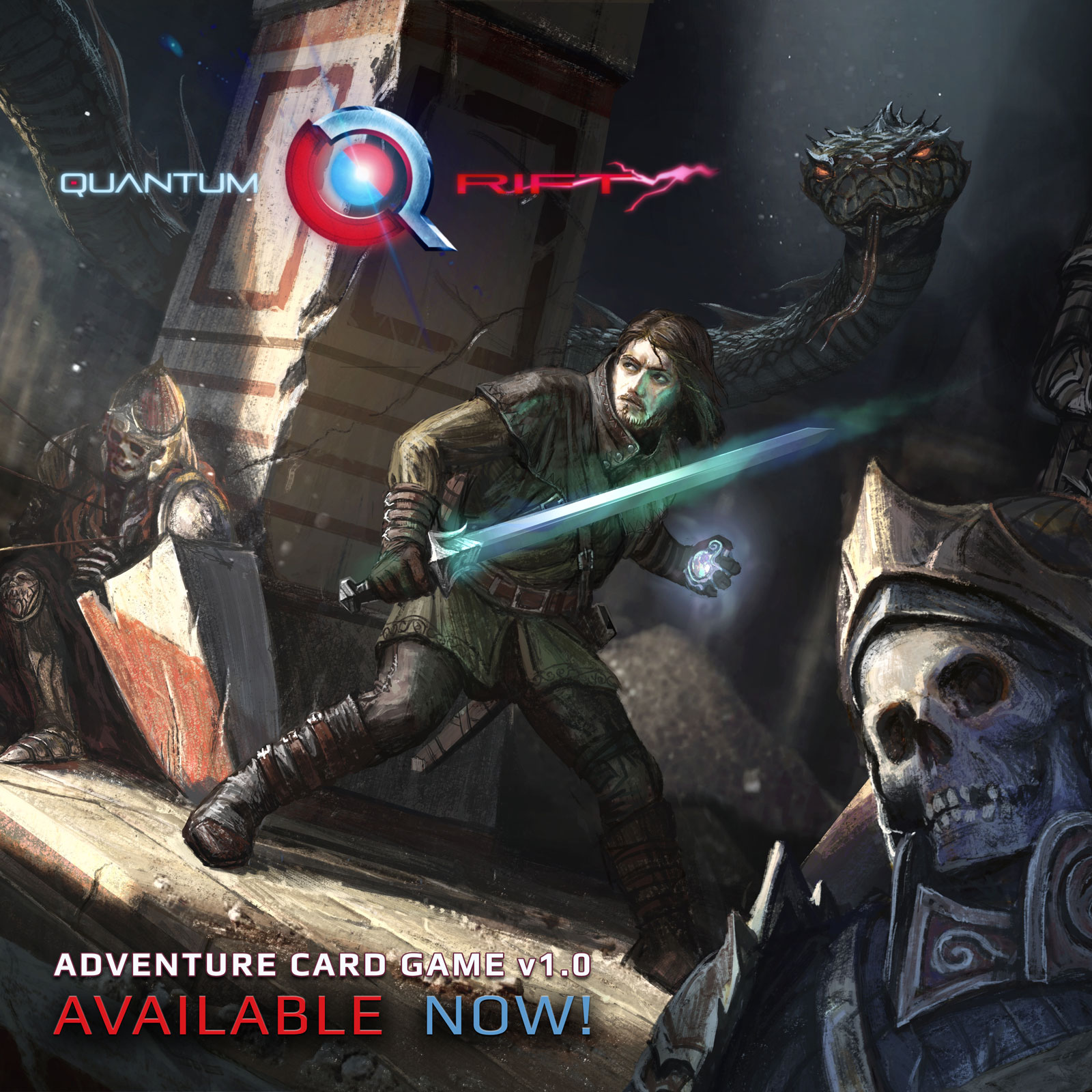
To download the zip archive containing 5 sheets of cards to print and the rulebook, just follow the big image link above.
UPDATE 3rd December: I have now added card backs and also some tips on printing and building in a README.txt file.
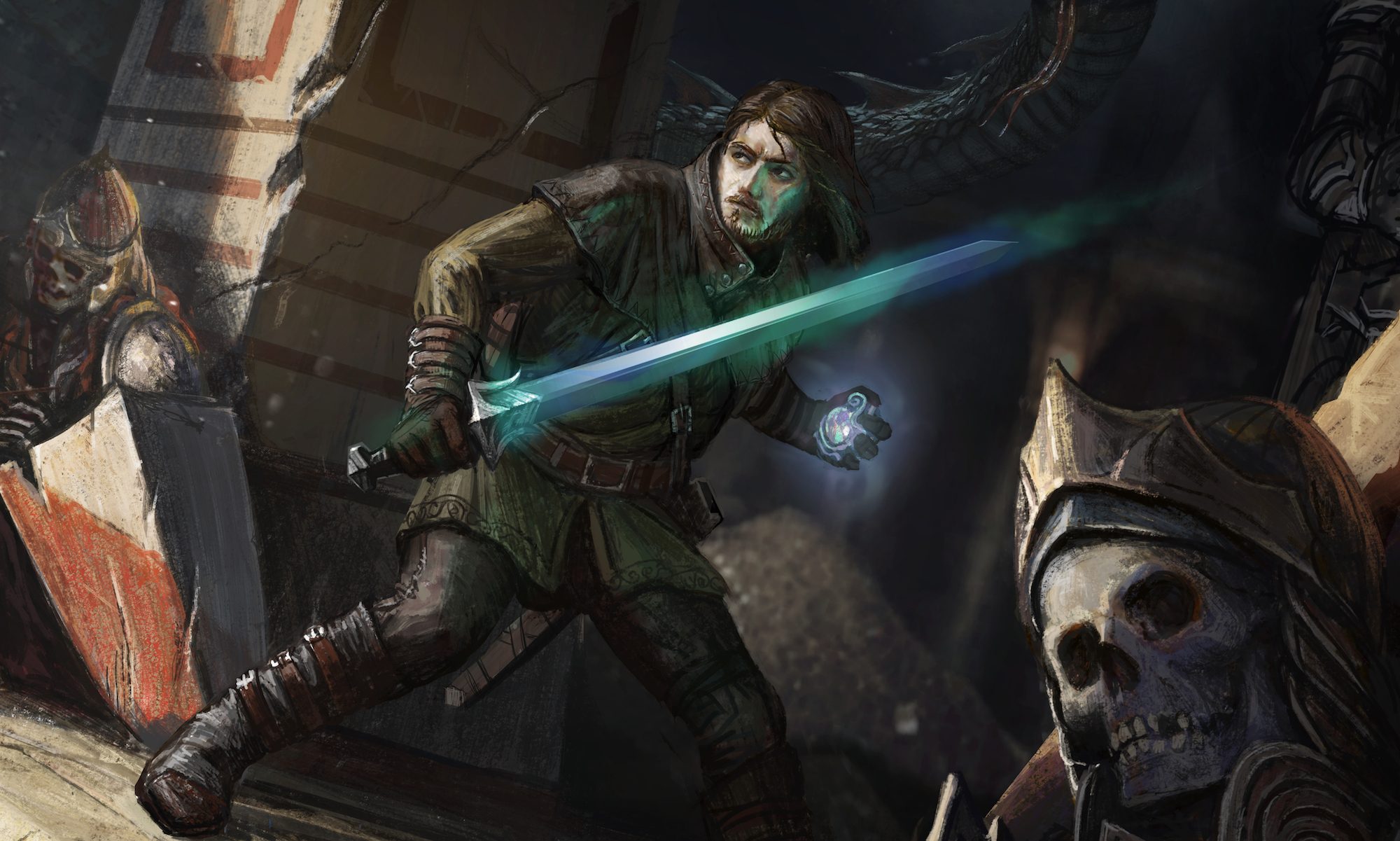
We’re very pleased to announce that all 41 cards of the first chapter of the Andares Adventure are now complete and this first instalment of our game will be available for you to download to print and play within the next 24 hours. In the meantime, you can check out all the cards below:


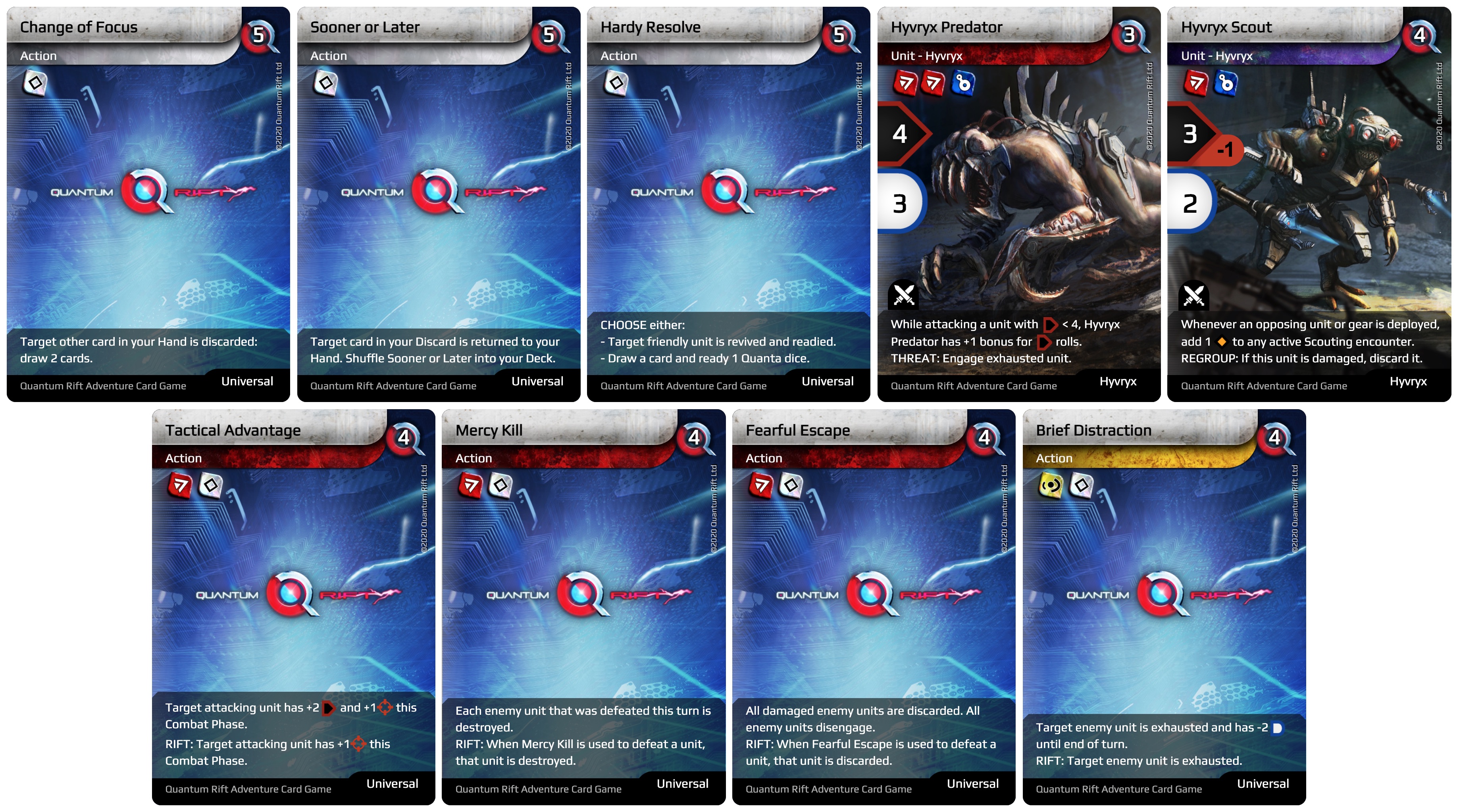


All that remains to be done before launch are some finishing touches to the rulebook and preparation of the final final PDFs for you to download and print your cards. Watch this space!
With the first free print-and-play release of our adventure card game fast approaching, there’s no better way to get yourself in the mood to play it than hearing this extended version of our Quantum Rift Main Theme, composed and orchestrated to perfection by Francesco Pirrone.
Give yourself a treat and check it out on YouTube now, and look out for the official release of this track and the original across all digital platforms mid-December!
During November 2020, we will be adding all cards from the print-and-play edition of the Quantum Rift Adventure Card Game onto our new Wiki, along with the basic rules for the game.
We will be doing this in readiness for making the print-and-play PDF sheets available to download (for free) and inviting people to give our game a try!
Any feedback we get will be used to help improve the game before the Kickstarter Campaign that will launch in Summer 2021.
If you are interested in being a playtester using the print-and-play edition, make sure you give our Facebook page a Like or comment on this post on the blog.
We are very pleased to share, on this very special date of 10/10/2020, the theme tune for the wider Quantum Rift Universe, within which all kinds of games, books, films, TV shows have the potential to be based. (The adventure card game we have been sharing is just a drop in the ocean of infinite possibilities.)
Additionally, we would like to announce that there is now a Quantum Rift Community private Discord server, where you can come and talk to us, and other people we are collaborating with to bring the Quantum Rift Universe to life. If you want to join, simply comment on the YouTube video, asking for the invite.
Hi there! If you were following this blog last year, you might have wondered what was happening with the game since May 2019 (or just forgotten about it altogether!).
Well, the truth is that I got a full-time day-job here in the UK on 3rd June and no longer had any time to work on Quantum Rift. Wanting to perform my new role as best I could, even spare time that might have gone on game development was put into anything I thought might help me deliver for my employer. That effectively put this project on hold, aside from more artwork being completed in the background by Lukasz (the other more-talented half of the QR team), in his spare time outside his own day-job.
However, while time was stolen from the project, the day-job has at least solved the financial aspect of creating the first print-and-play iteration of this game (and supporting my family) and it’s why I can be here now telling you about the bright future ahead!
Working on the game without any other income and having to live off savings to support a family of five just wasn’t sustainable, and it really limited how much I could invest in the resources and research that were needed to make Quantum Rift the best it can be.
Having said that, without those six months of living very frugally and focusing most of my time on the development of this game, then it would have had no future either. In other words, it’s all good and the path to Quantum Rift’s print and play launch is clear.
Speaking of which …

What you can see above is a preview of the first page of 9 cards from our print-and-play variant of the game. (Click here for the full 44MB PDF.)
Over the next couple of months, we will be finalising all cards and rules so that we run a Kickstarter for Chapter 1 of the first Quantum Rift Adventure.
In the mean time, I will resume making the blog posts that explore more of the rules and other interesting aspects of the game. See you soon!
Units within the Quantum Rift Adventure Card Game can either be ready, exhausted or damaged at any one time. We show exhausted with a blue counter, damaged with a red counter and ready (the default state) without either counter, as in the photo below.

Hopefully, it’s clear that becoming exhausted is not usually a problem because that only lasts until the start of the next turn, while becoming damaged is something to avoid unless you have some revival tricks up your sleeve (or in your hand). But, either way, if you are not ready when you get your chance to attack then you won’t be able to. Speaking of which, let’s look at the phases of the turn and see where this chance to attack might come.
Each of your turns playing the Quantum Rift Adventure Card Game proceeds through five phases after the start of turn, when exhausted units become ready again:
Thinking back to the predicament we left Sabrien Reed in at the end of our previous post, face-to-face with two Hyvryx Scouts thanks to the Seek and Destroy Encounter, let’s assume it’s the start of the turn and see how this plays out.

Deployment Phase – Although we might have some gear in hand to deploy, let’s assume we don’t deploy it now because of the first effect on each Hyvryx Scout, which would cause 2 Charge to be added to the Encounter! (“Whenever an opposing unit or gear is deployed, add 1 Charge to any active Scouting encounter”).
Combat Phase – At the start of this phase, all three units are ready and able to attack. Fortunately, for you, the attack order is decided by the player! Assuming Sabrien attacks first, the following outcomes are possible:
Given that Sabrien gets to roll 3 Attack dice with a +1 roll bonus and 1 guaranteed Hit, the last outcome seems very unlikely, especially with the chance to Rift. In fact, the chance to Rift on each roll and 4+ being considered an Attack success means you can virtually guarantee you will damage one of the Scouts, so let’s assume the first outcome is what happened. Great! For reasons that will become clear in a future post that covers the Combat Phase in more detail, let’s assume the remaining Scout does not attack Sabrien.
Explore Phase – Ordinarily, you might be able to do something interesting here (which you will see in the next post), but we must skip this phase if there is an active Encounter, so onto the next phase …
Threat Phase – We must trigger the THREAT effect of the Encounter, which puts 2 additional Charge on it.
Regroup Phase – We now trigger the REGROUP effect on the damaged Scout to discard it, leaving just the one ready Scout.
We’ve now reached the next turn, which we might expect would play out similarly to this one, with all units starting out ready again and Sabrien attacking, but something special happens after Sabrien damages the remaining Scout: there are no longer any ready Hyvryx units in play to satisfy the Encounter’s DURATION, so the Encounter ends immediately!
Hurrah! Sabrien has survived his first encounter on Andares. Not only that, he is about to get his first chance to explore this mysterious world, far away from his home, in both space and time! Be sure to join us next time when we will get to explore what happens next together.
When designing a character-based card game primarily for solo/co-op play, there’s an important challenge to solve in how opposing forces will be controlled. In today’s post, we will be exploring some of the mechanics we’ve chosen to use as part of our solution.
But, before we that, I’d like to briefly describe why we rejected the most obvious approach of creating a symmetrical game you play against a non-human “player”, with its own deck of cards and hand and turns to take actions, all controlled by some rules/heuristics or other form of Artificial Intelligence.
While this tends to be the default for the single-player Campaign/Adventure modes of digital trading cards games like Hearthstone and Shadow Era that are designed first and foremost to be played against other people, a physical (tabletop) game with only one human player requires all opposing card behaviours to be determined and enacted by proxy by that player. Having experimented with this originally, it did not take long to conclude the “work” involved in this for the player, compared to making their own choices and plays, can really dampen the fun factor.
So with the idea of a symmetrical game out the window, we considered the fairly standard approach used by traditionally solo/co-op games of building the behaviour of the enemy cards into the player’s turn through distinct turn phases, triggered effects and special cards. Let’s take a look at one of those special cards now!
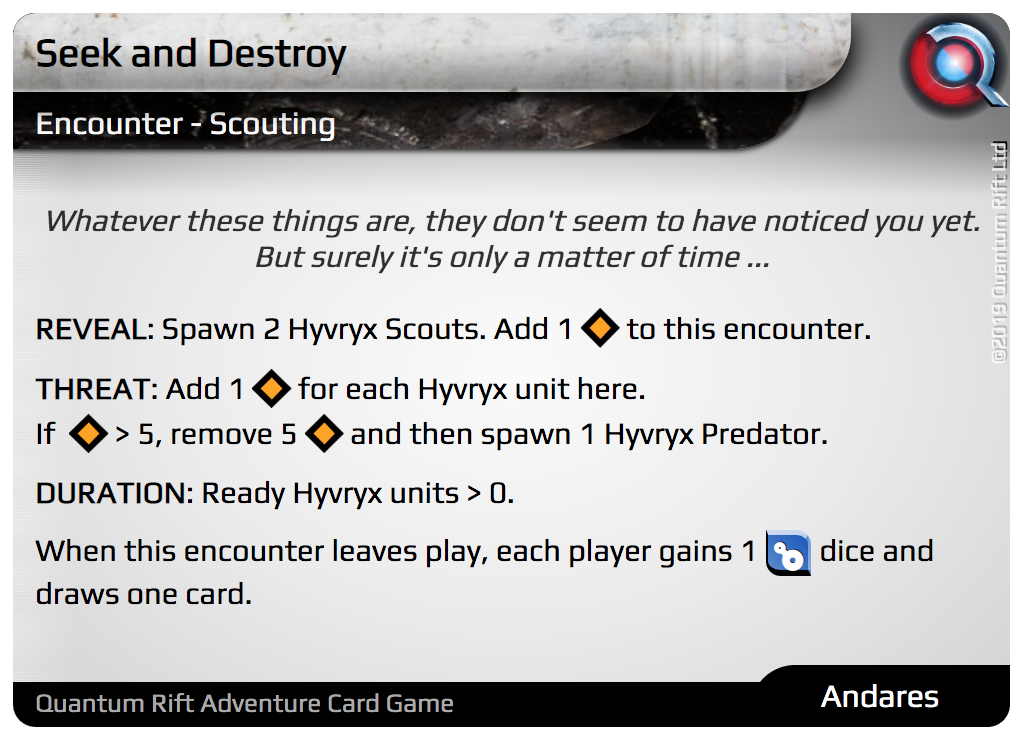
The first thing to notice is that this card is in landscape format and has no Quanta symbols and no Rift number. This is because it’s not a playable card that a player will ever have in their deck or hand, but a story card that embodies part of the particular adventure being played. The specifics of how an Encounter enters play will be detailed in a future post, but for now let’s assume that this one has been revealed at the start of a game after you have chosen Sabrien Reed as your hero, with The Shy Sword starting in play with him.
With that in mind, the next logical step is then surely to discuss the REVEAL effect, which triggers when this Encounter is revealed for the first time. Within seconds of Sabrien arriving in a distant time and place, with only his sword for company, he will be joined by two Hyvryx Scouts across from him (spawned from an Enemy Pile that was constructed as part of the game setup).
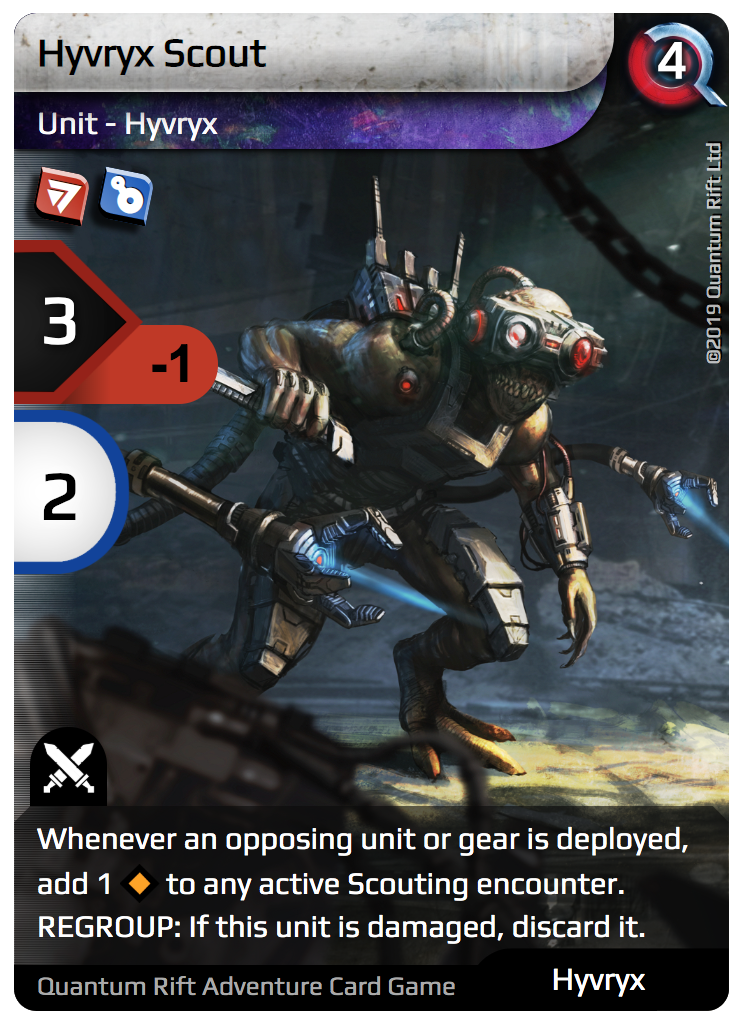
But that’s not all that happens! We also must add 1 Charge to the card, that will represent a growing threat to Sabrien while this Encounter persists. (A stack of counters/tokens or dice work well to track the current Charge.)
Speaking of a growing threat, let’s look at that next. The THREAT effect, which was first introduced on the Hyvryx Predator, is another that triggers at a specific time in the game, but this one actually happens on every turn during the player’s Threat Phase. Looking over the simple logic above, hopefully you can see that if the Hyvryx Scouts are left unchecked to continue their scouting then the aforementioned Hyvryx Predator will soon come join the fray. For Sabrien’s sake, we must determine how to bring this Encounter to an end as soon as possible! But how?
Thankfully, we must look no further than the next line down, where the DURATION specifier for the Encounter is written. Unlike REVEAL and THREAT, this is not an effect but an ongoing condition that says the Encounter will only remain in play while there is at least one “ready” Hyvryx unit. Sabrien is therefore going to need to find a way to make them all not ready somehow, or remove them from play completely, to end this Encounter before the Hyvryx insist on having him for dinner. Food for thought, I think you’ll agree!
With such high stakes (or should that be thigh steaks?), I think this is a good place to end for today, to give you some time to digest what we’ve covered and ensure the Hyvryx don’t get to digest what they’ve discovered … for now, at least.
When we return next time, we will look into the different states units can be in and the ordering of phases in a turn, which should hopefully bring forth some ideas as to how Sabrien might escape this Encounter. See you then!
Welcome back to our blog, where we are steadily revealing more details about the adventure card game we are developing, set in our brand new Quantum Rift Universe.
Now that we’ve introduced the concept of Quanta, through the Quanta symbols on cards and the coloured Quanta dice (see the image below for a reminder), our goal today is to explore the meaning behind these different symbols and colours.
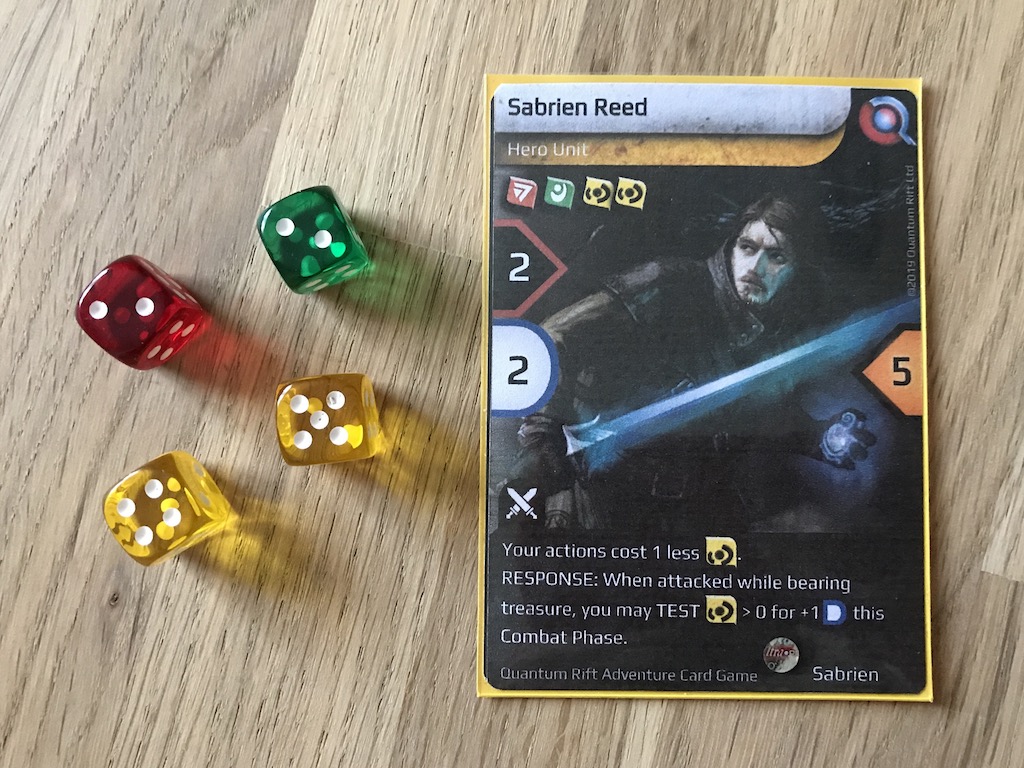
Just as everything in our universe can be viewed as energy in different forms, according to Einstein’s famous equation (E = mc2), everything in the Quantum Rift Universe is considered to be Quanta energy, which we classify into four main coloured types according to its different forms and applications:
Red represents the physical embodiment of Quanta within living creatures, chosen both for the colour of blood that pumps around the body and for the blood that can be spilled through acts of physical dominance! Consequently, within our card game, you can expect to see at least one red Quanta symbol on strong/athletic characters and those proficient in combat.
Yellow represents mental prowess within sentient beings, chosen for its associations with clarity and wisdom. Characters within our game with at least one yellow Quanta symbol can therefore be considered to have above average intelligence, intellect and mental acuity.
Green represents nature and the concepts of life and growth, chosen for obvious reasons! As such, all characters in our game that you would expect to survive (and potentially thrive) in the wilderness have at least one green Quanta symbol on their cards.
Blue represents technology and engineering (as opposed to natural development/evolution), chosen mostly because it was the only remaining primary colour! When a character in our game is particularly talented with technology or endowed with it, their card will have at least one blue Quanta symbol to show this.
Taking all this into account, what could we deduce about Sabrien Reed and the Hyvryx Predator revealed previously?
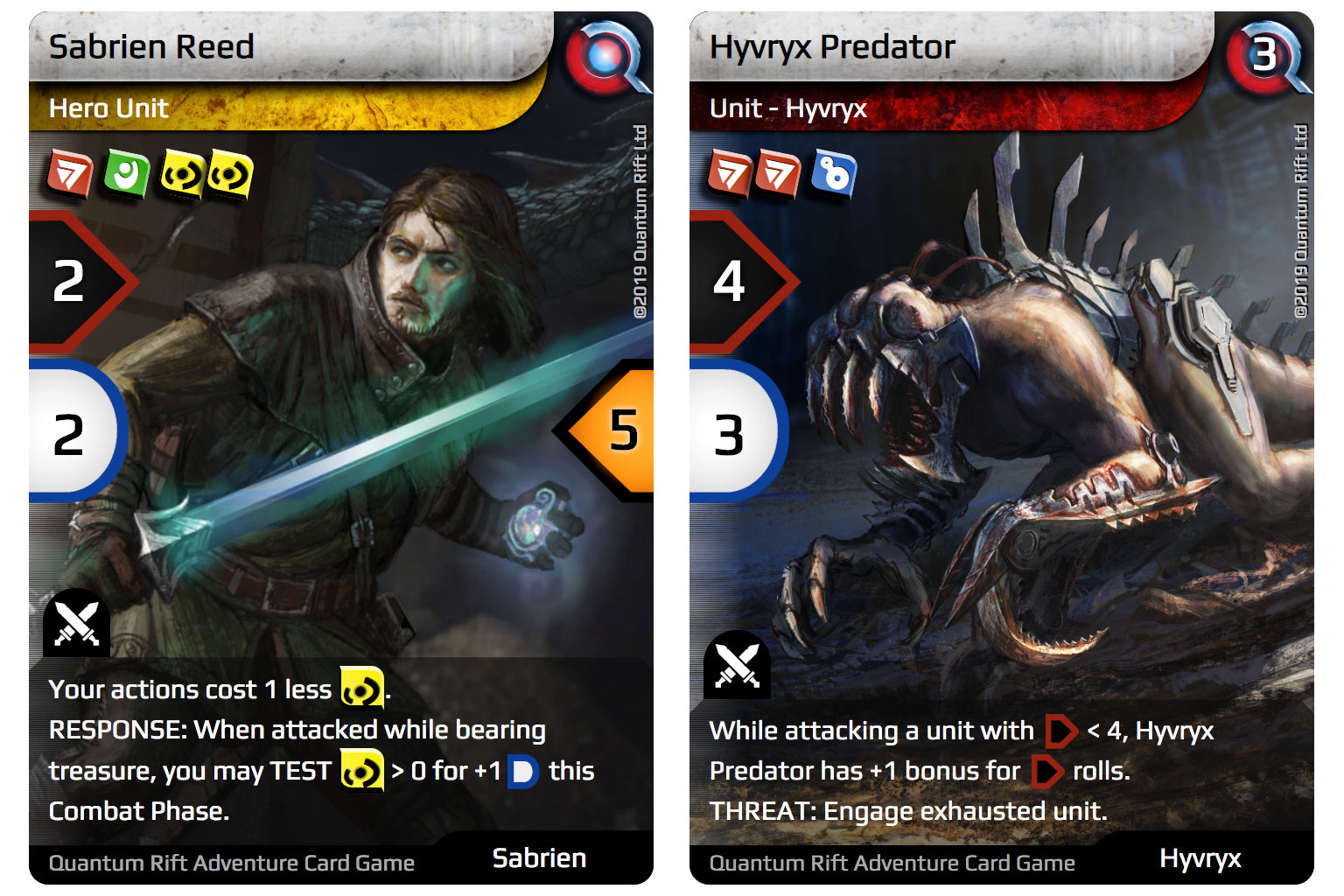
If you’ve concluded that Sabrien is likely an accomplished explorer and treasure-hunter from medieval times, armed with a sharp mind and abundance of worldly wisdom (from his world and time at least), you’ve hit the nail right on the head – which is pretty much Sabrien’s limit when it comes to technology!
On the other hand, or any hand in fact, the only thing we can conclude for now about the bioengineered Hyvryx Predator is that it is likely to lead to plenty of blood loss.
So one question remains for today: Will Sabrien’s weakness with technology be his undoing when he encounters the Hyvryx faction on his next adventure?
If this has you intrigued, be sure to tune in next time, when we reveal another Hyvryx unit and a new card type: Encounter.
Welcome back to the Quantum Rift Blog! If you missed our posts on Anatomy of a Card (Part 1 and Part 2), please read those before continuing, as we are building on the details shared there.
In today’s post, we will reveal further connections between the cards and dice in our game, and another innovation that brings additional skill, creativity and excitement to the connection shared last time: the option to Rift with a card in hand to boost any of your dice rolls. As with previous posts, we will do this with the aid of a new card, The Shy Sword, which is in Sabrien’s card pool and starts in your deck in your first adventure.
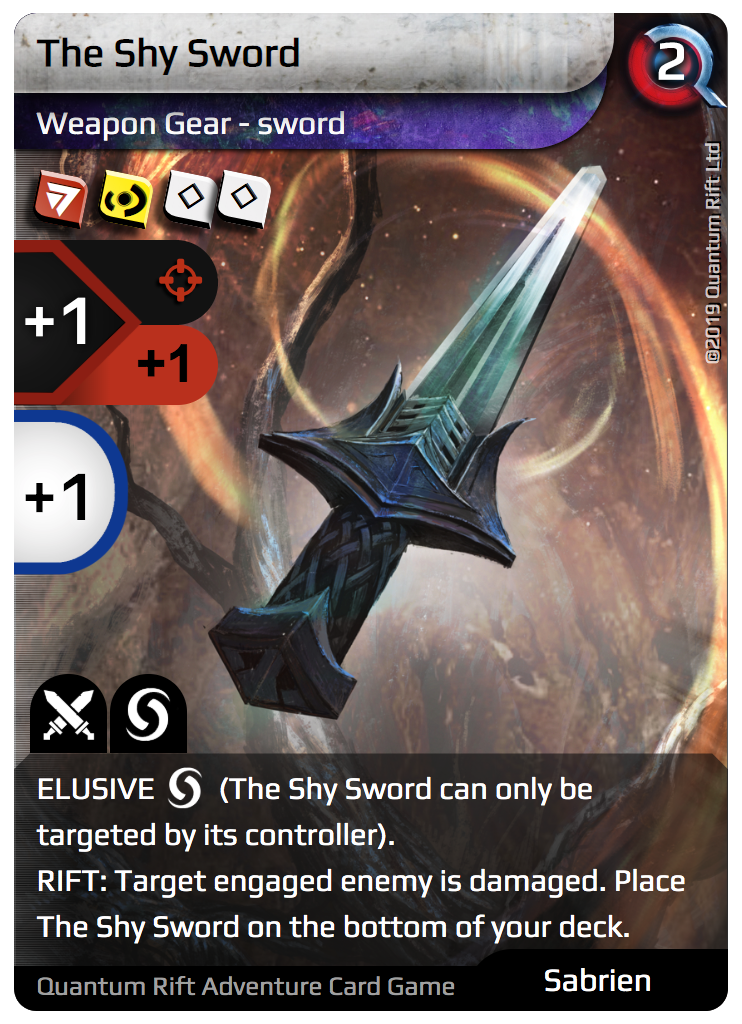
Let’s start with the Quanta symbols on The Shy Sword. Here we have 1 Red, 1 Yellow and 2 White (which means “any colour”). These represent the cost to deploy this weapon, but how will it be paid? Using your Quanta dice!
While some games used resources or mana as the “currency” for players to spend each turn, the Quantum Rift Adventure Card Game uses Quanta dice. At the beginning of the game, you receive dice matching those shown on your chosen Hero, which means 1 Red, 1 Green and 2 Yellow for Sabrien Reed.

When you have The Shy Sword in your hand and wish to deploy it, you will exhaust these four Quanta dice, using 1 Yellow and 1 Red and then the other Yellow and 1 Green to match the 2 White.
If you’re wondering why we use dice rather than simple tokens or counters, the short answer is that you can roll dice! One of the main reasons you might roll your Quanta dice is to perform a Quanta test, like the one in Sabrien’s game text which requires you to roll one or more ready (not exhausted) Yellow Quanta dice and get at least one success (a roll of 4 or more at default difficulty setting) to receive the +1 Defence.
Speaking of which, let’s return to the Rift action you can do on any of your dice rolls. In the previous post we revealed this means to add the Rift Number of a card in hand to your dice roll and then discard that card, but there is also the option to apply a Rift effect at the same time. Casting our eyes back to The Shy Sword, we can see one of its abilities is preceded by “RIFT:” which shows this is a Rift effect. Providing you have just rolled one of your dice – whether that be for an Attack, a Quanta test or some other reason – you can Rift with The Shy Sword to benefit from its effect for no cost other than discarding it. Rest assured, there are ways to get it back later because it’s a pretty good sword to have in play!
Which brings us nicely onto some bonus information for today. As you can see, the Attack value for The Shy Sword is +1, but it also has a Hit Icon (meaning 1 guaranteed Attack success) and an Attack Roll Bonus of +1 (meaning rolls of 3 or above are considered as Attack successes).
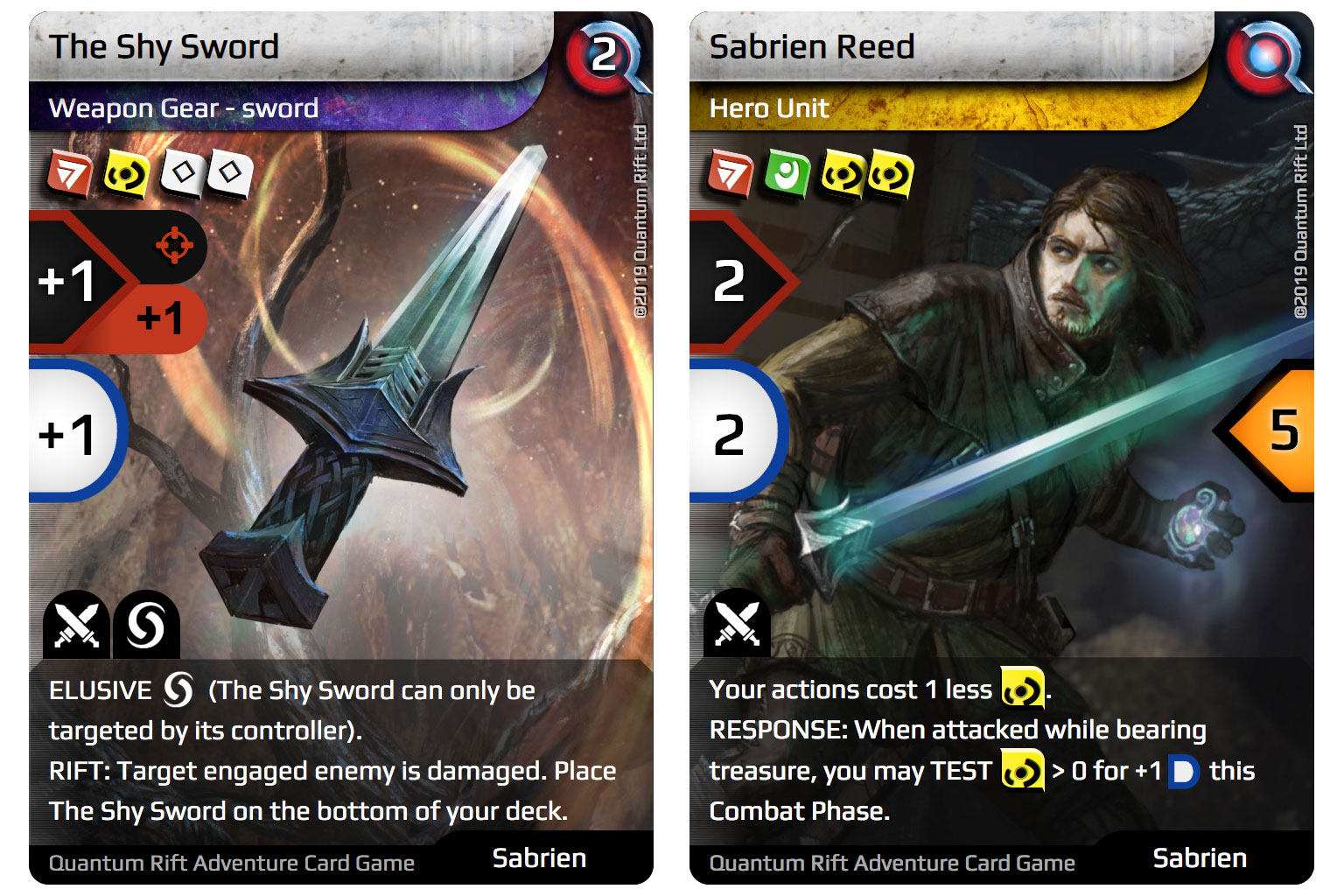
When Sabrien is equipped with The Shy Sword, you will now be able to roll 3 Attack dice and have a decent chance of getting 4 Attack successes in total (when the Hit Icon, the Attack Roll Bonus and option to Rift on any failures is taken into account).
You’ll also notice The Shy Sword boosts Sabrien’s Defence to 3, which can be further increased via his Response effect if you perform a successful Quanta test mentioned earlier.
We hope you’ve enjoyed hearing more about how the cards and dice in our adventure card game are connected and you are looking forward to playing. In our next post, we will reveal more about the meaning of Quanta, which goes much deeper than their colours. See you then!